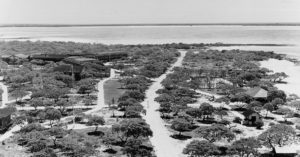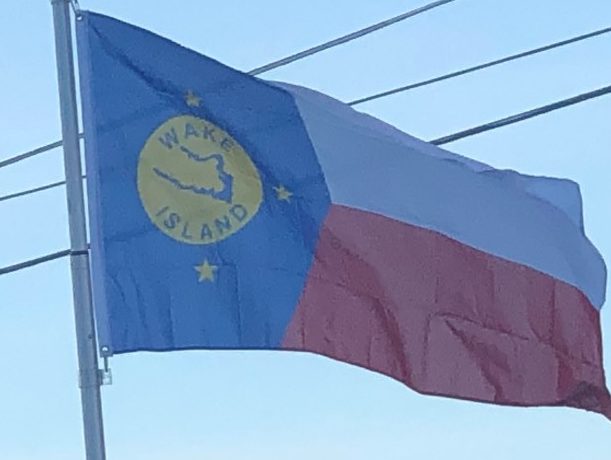Out in the middle of the lagoon, Bill Mullahey, a swimmer from Columbia University, was tasked with blasting hundreds of coral heads from a 1 mile long, 300 yards wide, 6 feet deep landing area for the flying boats.
On August 17, the first aircraft landing at Wake Island occurred when a PAA flying boat, on a survey flight of the route between Midway and Wake, landed in the lagoon.
The second expedition of North Haven arrived at Wake Island on February 5, 1936, to complete the construction of the PAA facilities. A five-ton diesel locomotive for the Wilkes Island Railroad was offloaded and the railway track was extended to run from dock to dock. Across the lagoon on Peale workers assembled the Pan American Hotel, a prefabricated structure with 48 rooms and wide porches and verandas. The hotel consisted of two wings built out from a central lobby with each room having a bathroom with a hot-water shower. The PAA facilities staff included a group of Chamorro men from Guam who were employed as kitchen helpers, hotel service attendants and laborers. The village on Peale was nicknamed “PAAville” and was the first “permanent” human settlement on Wake.
By October 1936, Pan American Airways was ready to transport passengers across the Pacific on its small fleet of three Martin M-130 “Flying Clippers”. On October 11, the China Clipper landed at Wake on a press flight with ten journalists on board. A week later, on October 18, PAA President Juan Trippe and a group of VIP passengers arrived at Wake on the Philippine Clipper. On October 25, the Hawaii Clipper landed at Wake with the first paying airline passengers ever to cross the Pacific. In 1937, Wake Island became a regular stop for PAA’s international trans-Pacific passenger and airmail service, with two scheduled flights per week, one westbound from Midway and one eastbound from Guam.

Wake Island is credited with being one of the early successes of hydroponics, which enabled Pan American Airways to grow vegetables for its passengers, as it was very expensive to airlift in fresh vegetables and the island lacked natural soil. PAAville remained in operation up to the day of the first Japanese air raid in December 1941, forcing the U.S. into World War II.
Military Buildup:
On February 14, 1941, President Franklin D. Roosevelt issued Executive Order 8682 to create naval defense areas in the central Pacific territories. The proclamation established “Wake Island Naval Defensive Sea Area”, which encompassed the territorial waters between the extreme high-water marks and the three-mile marine boundaries surrounding Wake. “Wake Island Naval Airspace Reservation” was also established to restrict access to the airspace over the naval defense sea area. Only U.S. government ships and aircraft were permitted to enter the naval defense areas at Wake Island unless authorized by the Secretary of the Navy.
Just earlier, in January 1941, the United States Navy began construction of a military base on the atoll. On August 19, the first permanent military garrison, elements of the U.S. Marine Corps’ First Marine Defense Battalion, totaling 449 officers and men, were stationed on the island, commanded by Navy Cmdr. Winfield Scott Cunningham. Also on the island were 68 U.S. Naval personnel and about 1,221 civilian workers from the American firm Morrison-Knudsen Corp.
